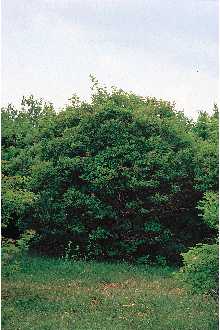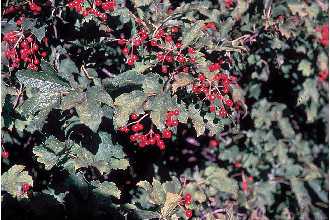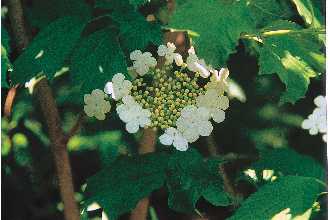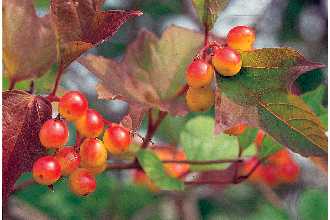American Cranberrybush
Scientific Name: Viburnum opulus L. var. americanum Aiton
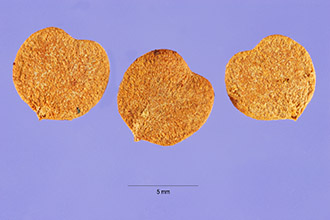
| General Information | |
|---|---|
| Usda Symbol | VIOPA2 |
| Group | Dicot |
| Life Cycle | Perennial |
| Growth Habits | ShrubTree, |
| Native Locations | VIOPA2 |
Plant Guide
Alternate Names
American cranberrybush, cranberry tree, crampbark tree, guelder-rose, wild gueldes-rose, gueldres-rose, cherry-wood, rose elder, red elder, marsh elder, water elder, white elder, gadrise, gaiter tree, gatten, love rose, May rose, pincushion tree, dog rowan tree, whitten tree, squaw bush, witch-hobble, witchhopple; synonyms: Viburnum trilobum Marsh.; Viburnum opulus ssp. trilobum (Marsh.) Clausen
Uses
Ethnobotanic: The bark of highbush cranberry yields a powerful antispasmodic (whence the origin of one its American common names, crampbark). The water-soluble preparation (containing a bitter compound called viburnine) has been used for relief of menstrual and stomach cramps and asthma. The antispasmodic properties apparently were discovered independently by European, Native American, and Asian peoples. The action of this agent from highbush cranberry closely resembles that of black haw (Viburnum prunifolium). Highbush cranberry is used as an ornamental plant and valued for its edible fruits. The fruit is commonly gathered from wild stands in late August or early September, best when picked slightly under-ripe (and sour), and used in sauces, jellies, and juices. If picked after a heavy frost, the fruit are softer and more palatable but they develop a musty, somewhat objectionable odor during cooking. The species has never developed into a commercial fruit crop. Wildlife: The bright red fruits often persist on the plants throughout the winter, good for ornamental value but suggesting that they may not be especially palatable for wildlife. Still, they are known to be eaten by deer, moose, foxes, raccoons, chipmunks, squirrels, skunks, mice, rabbits, grouse, pheasants, robins, cedar waxwings, and other songbirds. They are not normally eaten by birds until after they have frozen and thawed several times. Viburnum opulus © Hugh Wilson Vascular Plant Image Gallery Texas A&M Univ., Bioinformatics Working Group The native (American) plants of this species (= V. trilobum = V. opulus var. americanum, see below) are hardier as ornamentals, less susceptible to aphid attack, and have more intense fall color than the Eurasian plants, and they produce edible fruit. Fruit of the European plants tends to be bitter, and cultivars derived from the European species are grown strictly as ornamentals.
Status
Please consult the PLANTS Web site and your State Department of Natural Resources for this plant’s current status, such as, state noxious status and wetland indicator values.
Description
General: Honeysuckle family (Caprifoliaceae). Native shrubs to 4 m high, with upright, spreading, arching branches. Leaves deciduous, opposite, ovate, 5-12 cm long, deeply 3-lobed, coarsely toothed, with 1-6 large glands near the petiole apex, becoming yellow-red or reddish-purple in the fall. Flowers white, in flat-topped clusters 7-10 cm broad, with flowers of two different types, those in the outer ring sterile, showy, with expanded corollas 1-2 cm broad, the inner flowers much smaller, fertile, with yellow anthers. Fruit berry-like (a drupe), globose, bright red, 8-10 mm in diameter; stone single, strongly flattened. The common name alludes to the resemblance in fruit between the highbush cranberry and the cranberry of commerce (Vaccinium macrocarpon). Variation within the species. The North American plants have generally been recognized as the same species as the closely similar native of Europe, northern Africa, and northern Asia – V. opulus L. [var. opulus]. Var. opulus is said to differ from the American variety in its filiform-attenuate stipules and petiolar glands mostly short-pedicellate, round-topped to concave, and mostly wider than high. Voss (1996) notes that “variation between vars. opulus and americanum is too great – and too continuous – to make clear distinctions.” Variants have not generally been recognized from within the American segment of the species, but horticultural selections have been made from plants of both continents, primarily for leaf color, fruit color, and growth habit. The best known of these is the cultivated “snowball bush” (V. opulus var. roseum), a form developed from Old World plants, with spherical inflorescences of enlarged, completely sterile flowers (the "snowballs"). The native variety (var. americanum) is known to hybridize with cultivated or escaped ornamental forms of var. opulus. This may result in the gradual degradation or loss of the native genotype. Distribution: Var. americanum is widely distributed across north-central North America, from Newfoundland, Nova Scotia, New Brunswick, and Quebec to British Columbia, and in the US from Maine to Pennsylvania and West Virginia, northwestward to Washington. For current distribution, please consult the Plant Profile page for this species on the PLANTS Web site. The non-native var. opulus is frequently planted and sometimes escapes; it is recorded from Ontario and New Brunswick and various states in the northeastern quarter of the US – Maine to Virginia and West Virginia, westward to Wisconsin, Iowa, and Missouri.
Adaptation
Highbush cranberry grows in wet woods, along streams, and on moist wooded hillsides, requiring moist but well-drained sites for best development, Flowering (May-)June-July; fruiting August-September, , Use soil moisture sensors to measure the soil moisture of American Cranberrybush.
Establishment
The seeds are difficult to germinate; in the wild, seeds don't germinate until the second spring following the ripening of the fruit.
Management
Highbush cranberry is easy to grow, adaptable to a variety of soil and acidity, but it does best in consistently moist but well-drained soil. A yearly application of compost or well-rotted manure will maintain growth and fruit yields The plants are shade-tolerant, but flowering, fruiting, and foliage color will be best on plants in full sun. Plants may require occasional pruning to keep them from becoming leggy and to encourage the production of new shoots; prune immediately after flowering. Highbush cranberry can be propagated through hardwood and softwood cuttings, layering, crown division and by seed. Take softwood cuttings in mid-June through early-July for easiest rooting. Var. americanum is relatively -free from insect and disease damage in cultivation although bacterial leaf spot, powdery mildew, shoot blight, tarnished plant bugs, stem borers, and thrips will occasionally be a problem. Viburnum leaf beetle. The viburnum leaf beetle (Pyrrhalta viburni), native to Europe and Asia, was first encountered in North America in 1947, perhaps arriving earlier from Europe on nursery plants. It received little notice until 1978, when it caused severe defoliation of ornamental viburnums in Ontario and Quebec. It has now reached western New York and Maine and become a concern in urban landscapes and nurseries. The adult and the larva “skeletonize” leaves by feeding on the leaves between the midrib and larger veins. Plants which have been defoliated for 2-3 consecutive years may be killed. The preferred host is Viburnum opulus and its selections; lesser damage is caused to V. lantana and V. rafinesquianum, V. dentatum, V. acerifolium, and V. lentago. Other species, particularly V. rhytidophyllum and V. carlesii, are relatively unaffected. The entire life cycle of the viburnum leaf beetle takes about 8-10 weeks. Larvae hatch in early May and feed on the viburnum leaves throughout the larval period, which lasts 4-5 weeks. The larvae pupate in the soil. The adults (4.5-6.5 mm long, brown) appear by mid-July and continue eating the leaves, then mate and lay over-wintering eggs on the twigs. Egg-laying holes are in a straight line on the underside of the current season's growth. Chemical control of the viburnum leaf beetle is best applied to young larvae, because adults will fly away or drop to the ground if disturbed. If over-wintering egg sites are found, affected wood should be pruned and destroyed before the eggs hatch. Examine upper and lower leaf surfaces for feeding larvae. Potential biological control mechanisms are being studied. Cultivars, Improved and Selected Materials (and area of origin) These plant materials are somewhat available from commercial sources. Native plant cultivars with superior fruit and processing characteristics are available (for example: “Andrews,” “Hahs,” “Hogg's Red,” “Manitou,” “Phillips,” and “Wentworth”). The processed fruit is very similar to cranberry (Vaccinium macrocarpon) and red currant (Ribes rubrum). Contact your local Natural Resources
Conservation
Service (formerly Soil Conservation Service) office for more information. Look in the phone book under ”United States Government.” The Natural Resources Conservation Service will be listed under the subheading “Department of Agriculture.”
References
Barton L.V. 1958. Germination and seedling production of species of Viburnum. Pl. Propag. 8:126-136. Donoghue, M. 1980. Flowering times in Viburnum. Arnoldia 40:2-22. Donoghue, M. 1983. A preliminary analysis of phylogenetic relationships in Viburnum (Caprifoliaceae s.l.). Syst. Bot. 8:45-58. Egolf, D.R. 1962. A cytological study of the genus Viburnum. J. Arnold Arb. 43:132-172. Felter, H.W. & J.U. Lloyd 2000. Viburnum opulus. In King’s American Dispensatory. Web site. <http://metalab.unc.edu/herbmed/eclectic/kings/sambucus.html> Ferguson, I.K. 1966. The genera of the Caprifoliaceae in the southeastern United States. J. Arnold Arbor. 47:33-59. Finn, C. 1999. Temperate berry crops. Pp. 324–334. IN: J. Janick (ed.), Perspectives on new crops and new uses. ASHS Press, Alexandria, Virginia. <http://www.hort.purdue.edu/newcrop/proceedings1999/v4-324.html#cranberry> Friedlander, B.P., Jr. 1999. Voracious viburnum leaf beetle munches into Ithaca area. Cornell Chronicle. <http://www.news.cornell.edu/Chronicles/6.17.99/leaf_beetle.html> Giersbach J. 1937. Germination and seedling production of species of Viburnum. Contr. Boyce Thompson Inst. Pl. Res. 9:79-90. Hauser, E.J.P. 1965. Characteristics and distribution of Viburnum (Caprifoliaceae) in Georgia. Bull. Ga. Acad. Sci. 23:(11 pages). Hillebrand, G.R. &D.E. Fairbrothers 1969. A serological investigation of intrageneric relationships in Viburnum (Caprifoliaceae). Bull. Torrey Bot. Club 96:556-567. Jones, T.H. 1983. A revision of the genus Viburnum sect. Lentago (Caprifoliaceae). Ph.D. diss., North Carolina State Univ., Raleigh. Jones, E. & N.T. Wheelwright 1987. Seasonal changes in the fruits of Viburnum opulus, a freshly-fruiting temperate-zone shrub. Canad. J. Bot. 65:2291-2296. Kessel, C. 2000. Viburnum leaf beetle, Pyrrhalta viburni (Paykull), in the nursery and landscape. Ontario Ministry of Agriculture, Food and Rural Affairs, Ontario, Canada. Web site. <http://www.gov.on.ca/OMAFRA/english/crops/facts/vlb.htm> Krannitz, P.G. & M.A. Maun 1991. An experimental study of floral display size and reproductive success in Viburnum opulus: importance of grouping. Canad. J. Bot. 69:394-399. Krannitz, P.G. & M.A. Maun 1991. Insect visitors to guelder rose, Viburnum opulus var. opulus (Caprifoliaceae) in London, Ontario. Canad. Field-Naturalist 105:13-17. Lubbock J. 1891. On the form of the leaf of Viburnum opulus and V. lantana. J. Linn. Soc. Bot. 28:244-247. McAtee, W.L. 1956. A review of the Nearctic Viburnum. Published by the author, Chapel Hill, North Carolina. Pixler, VA. 1950. The Caprifoliaceae of West Virginia. Castanea 15:80-91. St-Pierre, R. 1995. The highbush cranberry - A multipurpose shrub. Internet publication. <http://www.google.com/search?q=cache:www.ag.usask.ca/cofa/departments/hort/hortinfo/fruit/cranbery.html+viburnum+trilobum&hl=en> Voss, E.G. 1996. Viburnum. Pp. 309-315. IN: Michigan Flora, Part III. Cranbrook Institute of Science Bull. 61.
Fact Sheet
Alternate Names
Viburnum opulus L.ssp. trilobum (Marsh.) Clausen, Viburnum trilobum Marsh.,highbush cranberry
Uses
Wildlife: American cranberrybush is a good wildlife food and cover plant for small mammals and birds. Twigs are eaten by deer, moose and beaver. Fruits are a staple winter food for ruffed grouse and are eaten sparingly by pheasants and at least five species of songbirds. Humans find the fruit tart but edible and excellent as a preserve or sauce. Erosion Control: The shrub is useful as a medium tall hedge or border for screening or a windbreak. Landscaping: It is an attractive flowering landscape plant for use in odd areas or in group plantings around homes and farm ponds. The fruit is a bright red which increases its ornamental value. Combined, its characteristics make it useful as a dual purpose food plant and ornamental.
Status
Please consult the PLANTS Web site and your State Department of Natural Resources for this plant’s current status (e.g. threatened or endangered species, state noxious status, and wetland indicator values).
Description
Viburnum trilobum Marsh,, American cranberrybush is an erect native shrub, averaging in height from 6 to 10 feet, occasionally taller on good sites, The plants are multi-stemmed but do not form thickets by spreading, They are dense shrubs because of close branching, The leaves are opposite, 3-lobed maple-like leaves and from 2 to 5 inches long, In the fall the leaves become scarlet, The creamy-white flowers, which appear in late May and early June, measure 3 to 4 inches across, Each bloom is composed of an outer ring of large sterile flowers and an inner ring of tiny fertile ones, The fruit, which ripens in September and October, resembles the true cranberry in size and color but is more translucent when ripe, Fruit hangs on the branches all winter, , Use soil moisture sensors to measure the soil moisture of American Cranberrybush.
Adaptation and Distribution
Distribution
Distribution
American cranberrybush is adapted throughout the Northeast, although distribution is widely scattered throughout much of its range. It is found growing in well-drained, imperfectly drained, and poorly drained, but not droughty soils. Soil pH is not critical, but for best results soil should be reasonably fertile. American cranberrybush is distributed throughout the northern states. For a current distribution map, please consult the Plant Profile page for this species on the PLANTS Website.
Establishment
Establish hedges or block plantings by using bare root or container grown stock. Plant 2 year old nursery seedlings. If planting your own seed, it takes 2 years for them to germinate.
Plant Traits
Growth Requirements
| Cold Stratification Required | No |
|---|---|
| Hedge Tolerance | Medium |
| Hedge Tolerance | Medium |
| Frost Free Days, Minimum | 90 |
| Frost Free Days, Minimum | 130 |
| Fire Tolerance | Medium |
| Fire Tolerance | Low |
| Fertility Requirement | Medium |
| Fertility Requirement | Medium |
| Drought Tolerance | None |
| Drought Tolerance | Medium |
| Cold Stratification Required | Yes |
| Temperature, Minimum (°F) | -38 |
| CaCO3 Tolerance | None |
| CaCO3 Tolerance | Low |
| Anaerobic Tolerance | Medium |
| Anaerobic Tolerance | Low |
| Adapted to Medium Textured Soils | Yes |
| Adapted to Medium Textured Soils | Yes |
| Adapted to Fine Textured Soils | Yes |
| Adapted to Fine Textured Soils | Yes |
| Adapted to Coarse Textured Soils | Yes |
| Adapted to Coarse Textured Soils | No |
| Moisture Use | High |
| Temperature, Minimum (°F) | -33 |
| Shade Tolerance | Intolerant |
| Shade Tolerance | Intermediate |
| Salinity Tolerance | None |
| Salinity Tolerance | None |
| Root Depth, Minimum (inches) | 14 |
| Root Depth, Minimum (inches) | 14 |
| Precipitation, Minimum | 35 |
| Precipitation, Minimum | 32 |
| Precipitation, Maximum | 60 |
| Precipitation, Maximum | 55 |
| Planting Density per Acre, Minim | 700 |
| Planting Density per Acre, Minim | 680 |
| Planting Density per Acre, Maxim | 1200 |
| Planting Density per Acre, Maxim | 1100 |
| pH, Minimum | 5.5 |
| pH, Minimum | 4.5 |
| pH, Maximum | 7.5 |
| pH, Maximum | 6.9 |
| Moisture Use | High |
Morphology/Physiology
| Active Growth Period | Spring and Summer |
|---|---|
| Toxicity | None |
| Toxicity | None |
| Shape and Orientation | Erect |
| Fire Resistant | No |
| Foliage Texture | Medium |
| Foliage Texture | Coarse |
| Foliage Porosity Winter | Porous |
| Foliage Porosity Winter | Moderate |
| Foliage Porosity Summer | Moderate |
| Foliage Porosity Summer | Dense |
| Foliage Color | Green |
| Foliage Color | Green |
| Flower Conspicuous | Yes |
| Flower Conspicuous | Yes |
| Flower Color | White |
| Flower Color | White |
| Resprout Ability | Yes |
| Fire Resistant | No |
| Fall Conspicuous | Yes |
| Fall Conspicuous | Yes |
| Coppice Potential | No |
| Coppice Potential | No |
| C:N Ratio | High |
| C:N Ratio | High |
| Bloat | None |
| Bloat | None |
| Active Growth Period | Spring and Summer |
| Shape and Orientation | Erect |
| Fruit/Seed Color | Red |
| Resprout Ability | No |
| Nitrogen Fixation | None |
| Nitrogen Fixation | None |
| Low Growing Grass | No |
| Low Growing Grass | No |
| Lifespan | Long |
| Lifespan | Long |
| Leaf Retention | No |
| Leaf Retention | No |
| Known Allelopath | No |
| Known Allelopath | No |
| Height, Mature (feet) | 4.5 |
| Height, Mature (feet) | 6.0 |
| Fruit/Seed Color | Red |
| Fruit/Seed Conspicuous | Yes |
| Fruit/Seed Conspicuous | Yes |
| Growth Form | Multiple Stem |
| Growth Form | Multiple Stem |
| Growth Rate | Slow |
| Growth Rate | Slow |
| Height at 20 Years, Maximum (fee | 4 |
| Height at 20 Years, Maximum (fee | 6 |
Reproduction
| Propagated by Seed | No |
|---|---|
| Propagated by Seed | Yes |
| Propagated by Sod | No |
| Propagated by Sod | No |
| Propagated by Sprigs | No |
| Propagated by Sprigs | No |
| Propagated by Tubers | No |
| Propagated by Tubers | No |
| Seed per Pound | 13000 |
| Seed per Pound | 13600 |
| Fruit/Seed Persistence | Yes |
| Seed Spread Rate | None |
| Seed Spread Rate | Slow |
| Seedling Vigor | Low |
| Seedling Vigor | Low |
| Small Grain | No |
| Small Grain | No |
| Vegetative Spread Rate | None |
| Vegetative Spread Rate | Slow |
| Propagated by Cuttings | No |
| Propagated by Cuttings | Yes |
| Bloom Period | Late Spring |
| Bloom Period | Mid Spring |
| Commercial Availability | Routinely Available |
| Commercial Availability | Routinely Available |
| Fruit/Seed Abundance | High |
| Fruit/Seed Abundance | Medium |
| Fruit/Seed Period Begin | Summer |
| Fruit/Seed Period End | Fall |
| Propagated by Bare Root | Yes |
| Propagated by Bare Root | Yes |
| Propagated by Bulb | No |
| Propagated by Bulb | No |
| Propagated by Container | Yes |
| Propagated by Container | Yes |
| Propagated by Corm | No |
| Propagated by Corm | No |
| Fruit/Seed Persistence | Yes |
Suitability/Use
| Palatable Browse Animal | Medium |
|---|---|
| Palatable Graze Animal | Low |
| Palatable Graze Animal | Low |
| Palatable Human | No |
| Palatable Human | Yes |
| Post Product | No |
| Post Product | No |
| Protein Potential | Low |
| Protein Potential | Low |
| Pulpwood Product | No |
| Pulpwood Product | No |
| Veneer Product | No |
| Veneer Product | No |
| Palatable Browse Animal | Low |
| Nursery Stock Product | Yes |
| Nursery Stock Product | Yes |
| Naval Store Product | No |
| Naval Store Product | No |
| Lumber Product | No |
| Lumber Product | No |
| Fodder Product | No |
| Fodder Product | No |
| Christmas Tree Product | No |
| Christmas Tree Product | No |
| Berry/Nut/Seed Product | No |
| Berry/Nut/Seed Product | No |

